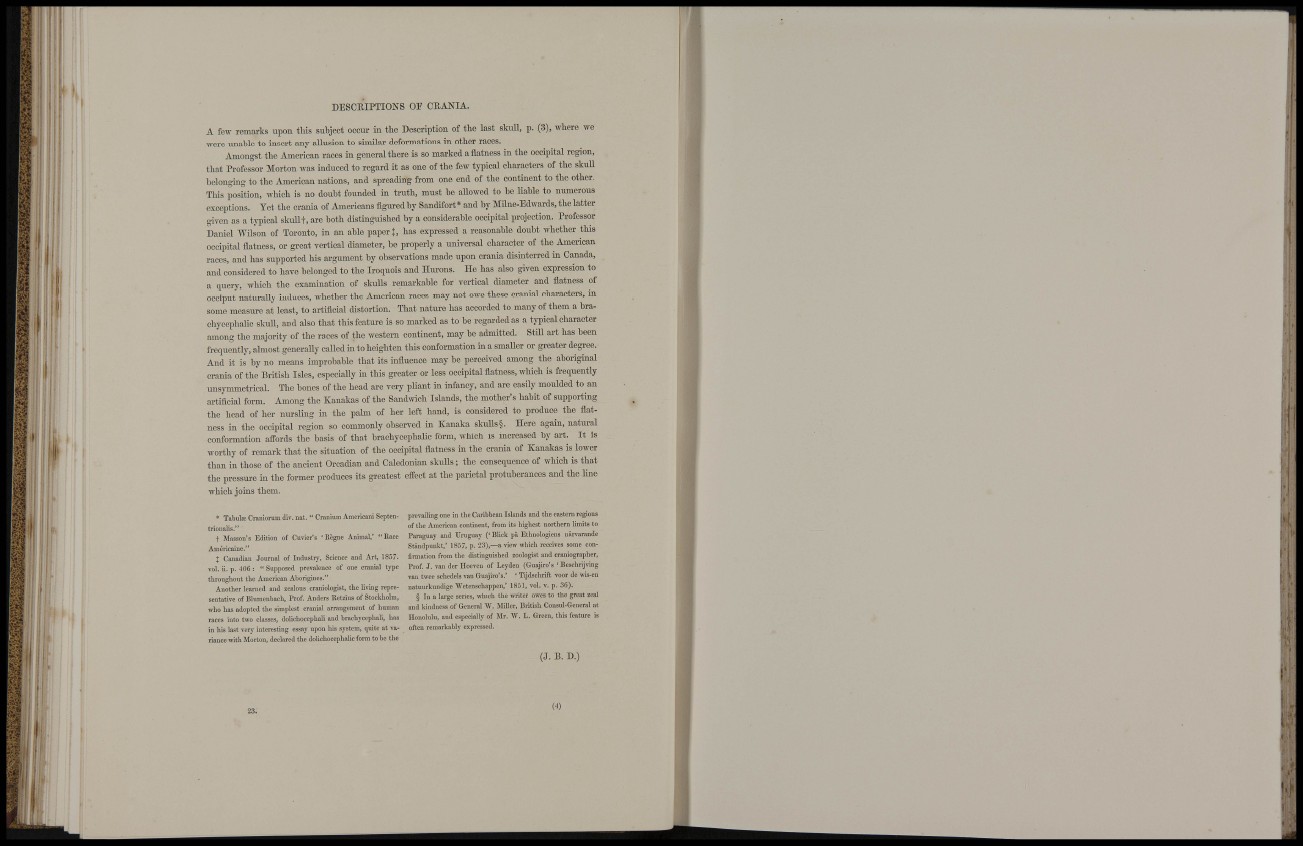
;
. !I.
DESCEIPTIONS OP CRANIA.
A few remarks upon tliis subject occur in the Description of the last skidl, p. (3), where we
were unable to insert any allusion to similar deformations in other races.
Amongst the American races in general there is so marked a flatness in the occipital region,
that Professor Morton was induced to regard it as one of the few typical characters of the skiúl
belonging to the American nations, and spreading from one end of the continent to the other.
This position, which is no doubt fovmded in truth, must be aUowed to be liable to nimierous
exceptions. Yet the crania of Americans figiu'ed by Sandifort * and by Müne-Edwards, the latter
given as a typical skullt, are both distinguished by a considerable occipital projection. Professor
Daniel Wüson of Toronto, in an able paper Í, has expressed a reasonable doubt whether this
occipital flatness, or great vertical diameter, be properly a universal character of the American
races, and has supported his argument by observations made upon crania disinterred in Canada,
and considered to have belonged to the Iroquois and Hurons. He has also given expression to
a query, which the examination of skulls remarkable for vertical diameter and flatness of
occiput naturally induces, whether the American races may not owe these cranial characters, in
some measure at least, to artificial distortion. That natiu-e has accorded to many of them a bra^
chycephalic slaiU, and also that this feature is so marked as to be regarded as a typical character
among the majority of the races of the western continent, may be admitted. StiU art has been
frequently, almost generally called in to heighten this conformation in a smaUer or greater degree.
And it is by no means improbable that its influence may be perceived among the aboriginal
crania of the British Isles, especially in this greater or less occipital flatness, which is frequently
unsymmetrical. The bones of the head are very pliant in infancy, and are easily moulded to an
artificial form. Among the Kanakas of the Sandwich Islands, the mother's habit of supporting
the head of her nursling in the palm of her left hand, is considered to produce the flatness
in the occipital region so commonly observed ia Kanaka skuUs§. Here again, natural
conformation affords the basis of that brachycephalic form, which is increased by art. It is
worthy of remark that the situation of the occipital flatness in the crania of Kanakas is lower
than in those of the ancient Orcadian and Caledonian skuUs; the consequence of wMch is that
the pressui-e in the former produces its greatest effect at the parietal protuberances and the line
which joins them.
h
* Tabute Craniorum div. nat. " Cranium Americani Septentrionalis."
t Masson's Edition of Cutier's 'Rcgne Animal,' "Ra c e
Amérieaine."
X Canadian Journal of Industry, Science and Art, 1857.
vol. ii. p. 406 : " Supposed prevalence of one cranial type
thronghout the American Aborigines."
Another learned and zealous craniologist, the living representative
of Blumenbach, Prof. Anders Retzins of Stockholm,
who has adopted the simplest cranial arrangement of human
races into two classes, dolichocephali and brachycephali, has
in his last very interesting essay upon his system, quite at variance
with Morton, declared the dolichocephalic form to be the
I i Í
prevailing one in the Caribbean Islands and the eastern regions
of the American continent, from its highest northern limits to
Paraguay and Ilmgnay (' Blick pii Ethnologiens niirvarande
Stiindpunkt,' 1857, p. 23),—a view which receives some eon-
6rmation from the distinguished zoologist and craniographer,
Prof. J . van der Hoeven of Leyden (Gnajiro's ' Besehrijving
van twee schedels van Guajiro's.' ' Tijdschrift voor de wis-en
natuurkundige Wetenschappen,' 1851, vol. v. p. 3G).
§ In a large series, which the writer owes to the great zeal
and kindness of General W. Miller, British Conaul-Gcneral at
Honolulu, and especially of Mr. W. L. Green, this feature is
often remarkably expressed.
(J. B. D.)
23. Í
;; f I